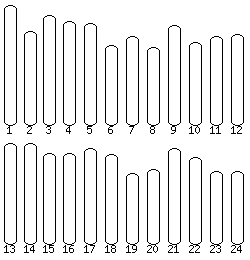Click on a chromosome for a closer view

 The Japanese medaka (Oryzias latipes) genome, which has been sequenced
by whole-genome
shotgun sequencing and by using Ramen assembler, is approximately 700Mb
in length and
comprises 24 pairs of chromosomes; 2 metacentric, 8 submetacentric, 1
subtelocentric
and 13 acrocentric chromosomes in haploid condition.
The genome sequencing and assembly for MEDAKA1 (October 2005) were
provided by
the National Institute of Genetics (NIG)
and the University of Tokyo.
The Japanese medaka (Oryzias latipes) genome, which has been sequenced
by whole-genome
shotgun sequencing and by using Ramen assembler, is approximately 700Mb
in length and
comprises 24 pairs of chromosomes; 2 metacentric, 8 submetacentric, 1
subtelocentric
and 13 acrocentric chromosomes in haploid condition.
The genome sequencing and assembly for MEDAKA1 (October 2005) were
provided by
the National Institute of Genetics (NIG)
and the University of Tokyo.
This Ensembl website presents sequence data provided by the two institutes. It also displays their gene set together with the Ensembl gene set and related analysis. See the data release policy for the medaka genome.
The gene set for Medaka was built using a modified version of the standard Ensembl genebuild pipeline. The species-specific sequence resources (medaka cDNA and protein) are very limited, so the majority of gene models are based on genewise alignments of proteins from other species that are genetically distant to medaka. To improve accuracy, genewise alignments were made to stretches of genomic sequence rather than to 'miniseqs'. Medaka cDNAs were aligned and used to add UTRs to the genewise predictions where possible. The gene models were then assessed by generating sets of potential orthologs to genes from other species. Potentially missing predictions and partial gene predictions were identified by examining the orthologs and used to improve the gene models. Finally, additional genes were predicted using medaka EST evidence, and medaka ESTs were used to add UTRs to the gene set where possible.
Canonical transcripts have been defined for all genes in the core databases.
Read more...
| Assembly: | HdrR, Oct 2005 |
| Genebuild: | Ensembl, May 2006 |
| Database version: | 50.1f |
| Known protein-coding genes: | 509 |
| Projected protein-coding genes: | 13,893 |
| Novel protein-coding genes: | 5,284 |
| Pseudogenes: | 1 |
| RNA genes: | 512 |
| Genscan gene predictions: | 123,380 |
| Gene exons: | 220,743 |
| Gene transcripts: | 24,662 |
| Base Pairs: | 700,369,883 |
| Golden Path Length: | 868,983,502 |
| Most common InterPro domains: | Top 40 Top 500 |
© 2024 Inserm. Hosted by genouest.org. This product includes software developed by Ensembl.